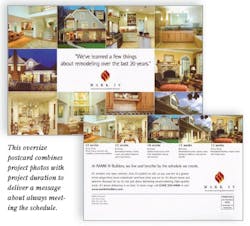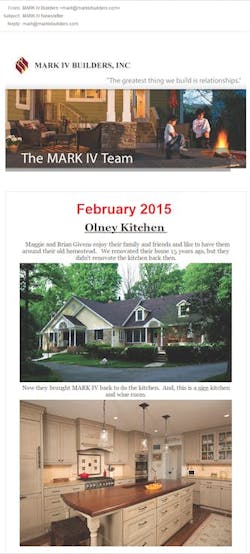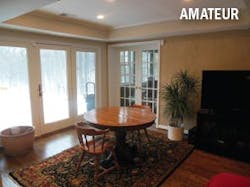Marketing: More Ways to Use Photographs in Your Marketing
Photographing our projects was a habit I got into early in my career. The original reason was to document our work and reduce liability, but over the years we’ve utilized the photos to develop highly effective marketing tools.
Here are a number of strategies that we’ve found helpful in showcasing our work.
1 Before, During, & After
We shoot every project at least three times: “before” photos of every room affected; in-progress shots showing critical details or the location of wiring, pipes, and ducts before the framing is covered; and “after” photos of the completed project. We put all of the images onto a CD and give a copy to the client, who can use it to show friends and family what a nice job we did with the project. The CD also comes in handy if we have to return to locate something hidden in a wall, but mostly we use it as a visual story to help potential clients visualize how their house could look.
2 Design Awards
I’m always surprised that more remodeling companies don’t enter design competitions. This often requires hiring a professional photographer, but it’s usually well worth the money (see “Hiring a Professional,” below). Even if you don’t win, it makes sense to frame prints and hang them on your office walls to show off your work.
You also might be surprised at how your team steps up its professionalism when its work is on display. That goes double if you win a design award, which is why I’m even more surprised that more remodelers don’t market their award wins. Yes, your Mom will be proud, but telling your Mom just isn’t marketing.
You already have the photos, so you’re halfway there. We’ve had a good response from mailing postcards announcing our contest wins. With a local or online printing company helping with the design and the copy, you can get postcards into prospects’ hands for less than 50 cents apiece.
3 Radius Mailing
For 25 years our company has been sending out mailings to addresses near each of our jobsites. I’m no longer surprised when I enter a prospect’s house to see our two-year-old mailing piece sitting on the table. We’ve tried different formats and frequencies, and have finally settled on three postcard mailings per project: one the week we start; a second during drywall; and the last shortly after we pick up our final check.
We usually print as many as 5,000 cards for each mailing, using an oversize 5 ½-by-8 ½-inch format to get more attention. The total cost for all three mailings is around $1,200. The printer holds most of the cards until we’re ready to mail.
This Google map outlines nearby neighborhoods that will receive mailings during an ongoing project. The mail house can exclude commercial addresses, apartments, etc., and mail only to qualified addresses.
After signing a project, we find the address on Google maps, print the page, and draw a circle around the area we want to target. When we send the map to the mail house, we ask them to provide only single-family homes, and no family trusts, corporate or absentee owners. We also request batch-mailing of 200 to 225 postcards at a time (the U.S. Post Office discounts the postage for mailings to more than 200 homes). The mail house does the rest.
Only occasionally do we get a call after the first mailing, but we typically total five to eight calls per project. If we sign another project in that same neighborhood, the postcard cycle starts all over again. Yes, the same folks are getting the same postcards, but coupled with our yard signs and the logos on our employees’ shirts and jackets, they see our logo over and over again. And that’s a good thing.
4 Newsletters
Another way to use photos you’ve already paid for is to fill a newsletter with images. Add some interesting stories, and over time, you’ll be surprised at the number of projects that come your way.
We used to mail a printed newsletter, which worked well, but it took a lot of time, and was expensive. We’ve since switched to an e-mailed version with a link on our site where people can sign up. It works as well or better than the print version, and it’s much cheaper. We spend about $40 per month using Constantcontact.com—not counting my time writing all of the content, which can take anywhere from an hour to most of a day.
If creating a newsletter from scratch seems daunting, a number of companies will put together a semi-custom newsletter for around $350 per month, which includes a generic article or two and space to add information specific to your company.
This email newsletter (right) uses big images and an informal, conversational, story-telling style to attract and hold readers’ attention. Many past clients look forward to receiving the monthly newsletter and pass it along to friends and neighbors.
5 Pitch Book
Pictures greatly help prospects evaluate your work and make it easy for them to talk about their project ideas. Whether you use a physical portfolio or keep your photos on a tablet or a notebook computer, using big, beautiful images enhances the sales process.
6 Public Relations
Newspaper and magazine editors are always looking for stories, especially stories with plenty of pictures. After I first had a piece published, I discovered that, in addition to the free advertising, there was another side benefit: I suddenly became a go-to source for other stories that the publication was writing. Besides the ego boost, it also led to more exposure for the company. And we were usually able to reprint the articles for use in our marketing.
Marketing is easy to put off because it usually doesn’t bear fruit immediately. But the idea that you can turn the marketing spigot on and off and get new projects whenever you want just isn’t realistic. These marketing tactics aren’t particularly difficult or expensive, but they have to be done regularly and often to be of any value.
Hiring a Professional
I’ve taken thousands of job photos over the past 27 years and, although they get the job done, they’re little more than snapshots. I don’t have the skill or the equipment to make a project “pop” the way a professional photographer can. Photographers know all the tricks—like filling glasses with red Kool-Aid instead of wine, which looks like blood, and sweeping a carpet so it shows an even knap. They are also adept at “improving” their photos using digital editing software.
If you intend to enter a project in a design competition, a professional photographer is critical. Most photographers either have experience with awards programs and know what the judges are looking for, or they can quickly figure it out by looking at photos from past winners.
These days you can hire a good professional photographer to take interior and exterior project shots for between $500 and $2,000 depending on the complexity of the project and the number of setups needed.
A professional photo exhibits better lighting and composition, and thoughtful staging (top). You can also schedule a professional shoot for a time of year that provides a more appealing background.
Online Photo Basics
When was the last time you opened a phone book to locate a store or restaurant? Few of us use—or can even find—a phone book anymore; instead we turn to the Internet.
Professional photos are great for posting on your website. Google’s Web crawlers read the text on your site, but your prospects are mainly looking at the pictures. By using photographs to tell a story, you’ll attract attention and interest. Add third-party validation by gathering and posting reviews of your work and your company from the clients whose projects you display. The combination of good-looking projects and glowing reviews is irresistible to serious prospects visiting your site.
If you haven’t done it already, set up a professional page on Houzz.com. The site is not not difficult to use and it’s free if you do it yourself. Uploading photos is easy, but it takes some work to develop keywords—terms most people type into the search box when looking for projects, photos, and design ideas. If you don’t spend some quality time developing keywords for both Houzz and your website, prospects will have a hard time finding you on the Internet.
To take a look at our Houzz page, go to Houzz.com and type “Mark Scott IV Builders” in the search bar. PR
---
Mark Scott, CR, is the owner of Mark IV Builders, in Cabin John, Md. Reach him at [email protected]





